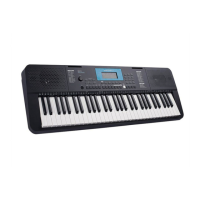Accompaniment Volume
1. Press [ACCOMP+] or [ACCOMP-] button to adjust the accompaniment
volume over the range of 0 to 127.
2. Press [ACCOMP +] and [ACCOMP-] button simultaneously to turn off
ACCOMP volume.
3. Press [ACCOMP +] and [ACCOMP-] button simultaneously again to
turn on ACCOMP volume.
Auto Accompaniment
15
Chord Fingering
Chord Basics
A chord, in music, is any harmonic set of three or more notes that is
heard as if sounding simultaneously. The most frequently encountered
chords are triads. A triad is a set of three notes that can be stacked in
thirds. When stacked in thirds, the triad's members, from lowest
pitched tone to highest, are called: the Root, the Third, and the Fifth.
Triad Type
There are following basic triad types:
Chord Inversion
We define this chord its root is not in the bass (i.e., is not the lowest
note) as an inversion chord. When the root is in the bass, we call the
chord: root-position chord. If we put the Third and Fifth in the root
position, then it forms “Inversion”, we call this chord “Inversion Chord”.
See the following major triad and its inverted chord.
Chord Name
The chord name contains two parts content: Chord root and Chord type.
Single Finger
Single finger type not only can detect single finger but also can detect
multi finger. And the single finger makes it easily to play chords through
only one, two or three keys. Including major, minor, seventh, and minor
seventh chord. Refer to relevant picture on the right for details.
Major Triad
Minor Triad
Augmented
Triad
Diminished
Triad
A root with a major third added above and a perfect fifth
will consist as a “Major Triad”.
A root with a minor third added above and a perfect fifth
will consist as a “Minor Triad”.
A root with a major third added above and an
augmented fifth will consist as an “Augmented Triad”.
A root with a minor third added above and a diminished
fifth will consist as a “Diminished Triad”.
C
M
Y
CM
MY
CY
CMY
K
AW_A810_Manual_G01_170809.pdf 15 17/8/9 16:21

